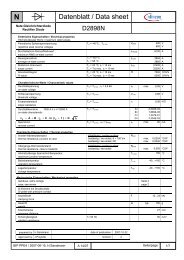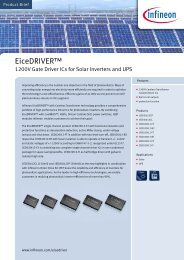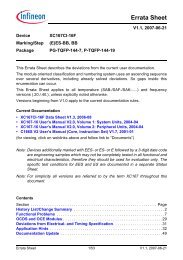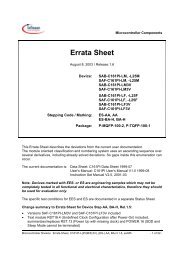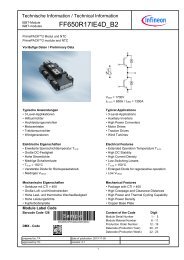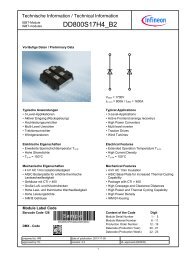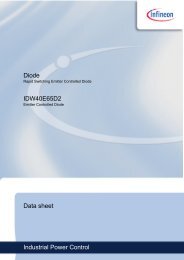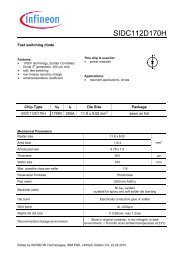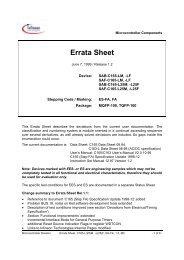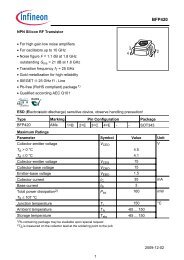Application Note CoolMOS™ CP - Infineon
Application Note CoolMOS™ CP - Infineon
Application Note CoolMOS™ CP - Infineon
You also want an ePaper? Increase the reach of your titles
YUMPU automatically turns print PDFs into web optimized ePapers that Google loves.
CoolMOS TM <strong>CP</strong><br />
- How to make most beneficial use of the latest<br />
generation of super junction technology devices<br />
4 Circuit Design and Layout Recommendations<br />
There are a number of recommendations to make with regards to circuit design and layout practices which will<br />
assure a combination of high performance and reliability. They can be recommended as if “in order of<br />
importance”, but realistically all are important, both in contribution toward circuit stability and reliability as well as<br />
overall efficiency and performance. They are not that dissimilar to recommendations made for the introduction of<br />
MOSFETs compared to bipolar transistors, or CoolMOS compared with standard MOSFETs; it is a matter of the<br />
degree of care.<br />
4.1 Control dv/dt and di/dt by proper selection of gate resistor<br />
In order to exert full Rg control<br />
on the device maximum turn-off<br />
dv/dt we recommend the<br />
following procedure:<br />
1. Check for highest<br />
peak current in the<br />
application.<br />
2. Choose Rg<br />
accordingly not to<br />
exceed 50V/ns.<br />
3. At normal operation<br />
condition quasi ZVS<br />
condition can be<br />
expected, which<br />
gives best efficiency<br />
results.<br />
dv/dt, Turn Off [V/µs]<br />
200000<br />
180000<br />
160000<br />
140000<br />
120000<br />
100000<br />
80000<br />
60000<br />
40000<br />
20000<br />
Rg= 3.3 ohm<br />
Rg= 6.8 ohm<br />
Rg= 13 ohm<br />
Rg= 33 ohm<br />
Rg= 68 ohm<br />
0<br />
0 2 4 6 8 10 12 14 16 18<br />
Load Current [A]<br />
Figure 16 dv/dt for different load currents and gate drive resistances<br />
for IPW60R199<strong>CP</strong> (switching to 400V, Tj=125 °C).<br />
Table 4 gives the Rg values for 50 V/ns and 30 V/ns at rated nominal current for each part as a quick<br />
guideline. Figure 16 also shows the turn-off dv/dt behavior for IPW60R199<strong>CP</strong> with several Rg values from<br />
3.3 Ohms to 68 Ohms. An Rg value of 30 Ohm looks fairly optimal in order to exert full Rg for high currents<br />
and still keep quasi ZVS condition at lower currents. Keep in mind that the gate resistor scales with device<br />
size and area related capacitance. The value for Rg inversely scales with different MOSFETs. Further<br />
detailed switching characteristics can be found in Appendix.<br />
CoolMOS TM Type RDSon,max ID Rg for dv/dt < 50V/ns Rg for dv/dt < 30V/ns<br />
IPP60R385<strong>CP</strong> 385 mΩ 9 A 30 Ω 64 Ω<br />
IPP60R299<strong>CP</strong> 299 mΩ 11 A 30 Ω 62 Ω<br />
IPP60R199<strong>CP</strong> 199 mΩ 16 A 30 Ω 60 Ω<br />
IPP60R165<strong>CP</strong> 165 mΩ 21 A 26 Ω 50 Ω<br />
IPP60R125<strong>CP</strong> 125 mΩ 25 A 19 Ω 37 Ω<br />
IPP60R099<strong>CP</strong> 99 mΩ 31 A 15 Ω 28 Ω<br />
IPW60R045<strong>CP</strong> 45 mΩ 60 A 10.5 Ω 17.5 Ω<br />
Table 4 Design guideline showing necessary gate resistance values for reaching dv/dt turn off values<br />
below 50 V/ns and 30 V/ns, respectively.<br />
13 of 32



